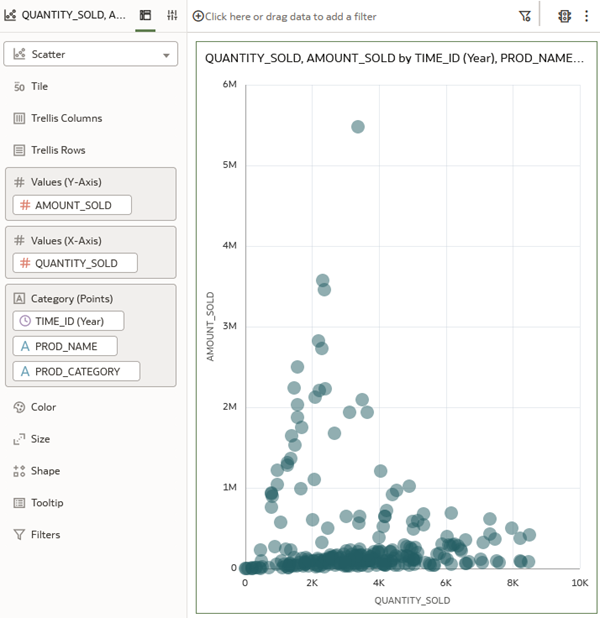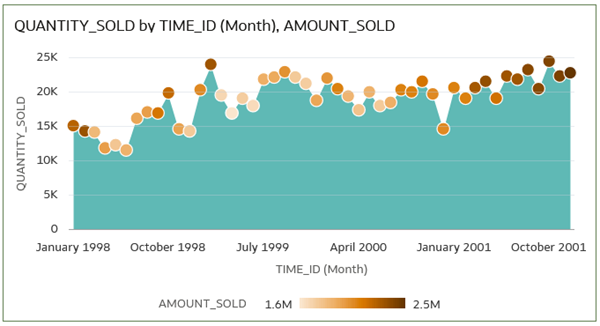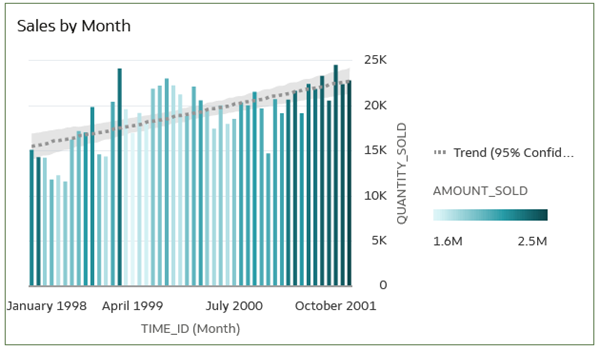Before you Begin
This 15-minute tutorial shows you how to use a connection to an Oracle Autonomous Data Warehouse to create a multiple table dataset and visualizations.
Background
This tutorial uses a connection to Oracle Autonomous Data Warehouse from Oracle Analytics. You create a dataset using the sample SH schema in Oracle Autonomous Data Warehouse, and then you create visualizations to analyze the sales history data of an electronics store.
What Do You Need?
- Access to Oracle Analytics
- Access to Oracle Autonomous Data Warehouse SH schema
Create an Oracle Autonomous Data Warehouse Dataset
This section shows you how to create a dataset from a connection to Oracle Autonomous Data Warehouse. The sample SH schema uses well-defined relationships so that you can create the dataset with the Auto Join Tables option enabled.
- Sign in to Oracle Analytics.
- On the Home page, click Create, and then click Dataset.
- In Create Dataset, click your Oracle Autonomous Data Warehouse connection.
- In the Connections panel, expand the SH schema.
- Hold down the Ctrl key, click the CUSTOMERS, SALES, PRODUCTS, COUNTRIES and TIMES tables, and then drag and drop them on the Join Diagram.
- Click Save. In Save Dataset As, enter
Sales_History, and then click OK.
Description of the illustration sales_history.png
Create Your First Visualization
- Click Create Workbook.
- In the Data pane, expand the PRODUCTS folder.

Description of the illustration oac_adw_data_set.png - Hold down the Ctrl key, select PROD_NAME and PROD_CATEGORY from the PRODUCTS folder and drag the data elements to the canvas.
Oracle Analytics creates a table visualization.

Description of the illustration prod_table_vis.png - Expand the SALES folder. Hold down the Ctrl key, select AMOUNT_SOLD and QUANTITY_SOLD from the SALES folder and drag the data elements to the table visualization.
- Expand the TIMES and expand the TIME_ID folders. Hold down the Ctrl key, select Year from the the TIME_ID folder, and then drag the data element to the table visualization.
- In the Grammar pane, select Scatter
 from the visualization type list
from the visualization type list  .
.

Description of the illustration scatter_vis.png - In Category (Points), select TIME_ID (Year) and move it to Color. Select PROD_CATEGORY and move it to Shape.

Description of the illustration sales_summary.png - Click Properties
 , click Auto in the Title row, select Custom, and then enter
, click Auto in the Title row, select Custom, and then enter Sales Summary. - Click Save. In Save Workbook, enter
Sales History WBKin Name, and then click Save.
Create a Visualization to Sales for Each Month
In this section you create a visualization that answers the question, "What are my monthly sales by dollar and quantity sold?"
- In the Data pane, hold down the Ctrl key, and select the following:
- AMOUNT_SOLD
- QUANTITY_SOLD
- Month
- Drag the data elements next to the existing visualization, and release when a thick green line appears in the canvas.
Oracle Analytics automatically creates a Stacked Area visualization.

Description of the illustration sales_by_month.png - Click Visualization Type
 , and select Combo
, and select Combo  .
. - In the Grammar panel, right-click QUANTITY_SOLD, and select Bar.
- Click Properties
 . In the General tab, click Auto in the Title row, click Custom, and then enter
. In the General tab, click Auto in the Title row, click Custom, and then enter Sales by Month.
Description of the illustration bar_sales_by_month.png - In the Sales by Month visualization, click Menu
 , select Add Statistics, and then click Trend Line. Click Save.
, select Add Statistics, and then click Trend Line. Click Save.
Description of the illustration sales_by_month_trend.png
Learn More
Create Your First Visualization with Data from Oracle Autonomous Data Warehouse
F13714-09
March 2025
Learn how to create visualizations in Oracle Analytics from an Oracle Autonomous Data Warehouse multiple table dataset.
This software and related documentation are provided under a license agreement containing restrictions on use and disclosure and are protected by intellectual property laws. Except as expressly permitted in your license agreement or allowed by law, you may not use, copy, reproduce, translate, broadcast, modify, license, transmit, distribute, exhibit, perform, publish, or display any part, in any form, or by any means. Reverse engineering, disassembly, or decompilation of this software, unless required by law for interoperability, is prohibited.
If this is software or related documentation that is delivered to the U.S. Government or anyone licensing it on behalf of the U.S. Government, then the following notice is applicable:
U.S. GOVERNMENT END USERS: Oracle programs (including any operating system, integrated software, any programs embedded, installed or activated on delivered hardware, and modifications of such programs) and Oracle computer documentation or other Oracle data delivered to or accessed by U.S. Government end users are "commercial computer software" or "commercial computer software documentation" pursuant to the applicable Federal Acquisition Regulation and agency-specific supplemental regulations. As such, the use, reproduction, duplication, release, display, disclosure, modification, preparation of derivative works, and/or adaptation of i) Oracle programs (including any operating system, integrated software, any programs embedded, installed or activated on delivered hardware, and modifications of such programs), ii) Oracle computer documentation and/or iii) other Oracle data, is subject to the rights and limitations specified in the license contained in the applicable contract. The terms governing the U.S. Government's use of Oracle cloud services are defined by the applicable contract for such services. No other rights are granted to the U.S. Government.
This software or hardware is developed for general use in a variety of information management applications. It is not developed or intended for use in any inherently dangerous applications, including applications that may create a risk of personal injury. If you use this software or hardware in dangerous applications, then you shall be responsible to take all appropriate fail-safe, backup, redundancy, and other measures to ensure its safe use. Oracle Corporation and its affiliates disclaim any liability for any damages caused by use of this software or hardware in dangerous applications.
Oracle and Java are registered trademarks of Oracle and/or its affiliates. Other names may be trademarks of their respective owners.
Intel and Intel Inside are trademarks or registered trademarks of Intel Corporation. All SPARC trademarks are used under license and are trademarks or registered trademarks of SPARC International, Inc. AMD, Epyc, and the AMD logo are trademarks or registered trademarks of Advanced Micro Devices. UNIX is a registered trademark of The Open Group.
This software or hardware and documentation may provide access to or information about content, products, and services from third parties. Oracle Corporation and its affiliates are not responsible for and expressly disclaim all warranties of any kind with respect to third-party content, products, and services unless otherwise set forth in an applicable agreement between you and Oracle. Oracle Corporation and its affiliates will not be responsible for any loss, costs, or damages incurred due to your access to or use of third-party content, products, or services, except as set forth in an applicable agreement between you and Oracle.